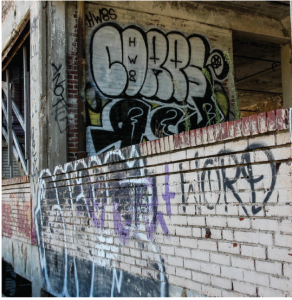An observation of art on deteriorating buildings in urban and impoverished areas.
By: Will Murry
Staff Writer
Recently, as I’ve driven down I-70/44, I realized how many buildings in this town are seemingly just left to rot. Despite popular belief and their derelict appearance they’re actually owned by somebody, typically a corporation or the city, and they are covered in graffiti. Usually when I see a vandalized storefront I feel sympathetic for the business owner.
However, I don’t feel as sympathetic for the corporation when the same thing happens to the abandoned building. I had to ask myself why I felt this way. Why don’t I feel as bad for this big company as I do the store owner when both are victims of the same crime? The conclusion I came to was simple: the use of the property.
The store owner has to pay out of pocket to make repair. They actively use and sell their product out of the storefront, most likely making just enough to feed their family and make rent. The likelihood of the small business owner having enough money lying around to pay for damages is slim.
The abandoned building, however, is getting practically no use at all, sitting empty for years and growing more decrepit. The abandoned building is past the point of salvaging, most often because the city or company that owns it doesn’t have the decency to give it the care it needs. Nor are they willing to cut their losses and tear down the building so the land can see some actual use.
As a result, the building gets tagged by a local graffiti artist, the first tag of many which seem to spread like an artistic infection all over the walls and windows. The decaying state of the building is the initial wound that the infection spreads through. I see graffiti as the surrounding community’s way of telling whoever owns the building that they should do something with the property by way of direct action. The community doesn’t want this eye sore of a building in their neighborhood, not only depreciating the value and contributing almost nothing to the community but also acting as a safe haven for homeless junkies and other dangerous people to inhabit. It isn’t just a stain on the good hardworking people and families who live in the surrounding neighborhood, but also a danger to their wellbeing.
While photographing some of these buildings, I fully realized the danger that these buildings bring to the surrounding communities. Some of them are structurally sound but I saw so many that were closer to residential neighborhoods and in worse shape. Universally there was proof of them being inhabited illegally, and judging by the drug paraphernalia odds are that their inhabitants were doing more than just living there. There was even a building that used to be “Bus Loop Burgers”, held up by two by fours and barely fenced off.
Children live and play right next to these potential dangers. The surrounding residents are good people that don’t deserve to live in conditions like these. These buildings are dangerous to these communities, but they don’t have to be. They should be used to benefit these people, and if they are past the point of rehabilitation, they should be torn down.










